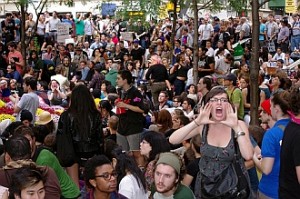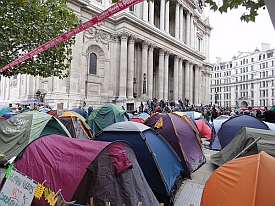 As Occupy Wall Street begins to inch ever closer to its first anniversary, and 6 months since Occupy became a global phenomena, the movement is finding it difficult to maintain momentum and continue achieving tangible results. Whilst many will state that changing the parameters of national conversation is the only result needed, the initial burst into our collective psyche is beginning to fade as the camps are all but dismantled and Occupy enters phase two (or three?).
As Occupy Wall Street begins to inch ever closer to its first anniversary, and 6 months since Occupy became a global phenomena, the movement is finding it difficult to maintain momentum and continue achieving tangible results. Whilst many will state that changing the parameters of national conversation is the only result needed, the initial burst into our collective psyche is beginning to fade as the camps are all but dismantled and Occupy enters phase two (or three?).
Following on from the initial post that I wrote last October, with this post I want to explore some general observations that have emerged since; hopefully bringing to the table a framework that helps both observers and participants better understand the complicated and varied experience that is Occupy.
The framework that began to emerge whilst contemplating recent experiences is that you can view Occupy as a series of binary oppositions. With each of these oppositions one exists at a point somewhere along the continuum presented, and affinity groups form from the overall matrix of identity created as we find ourselves drawn more closely to those who share similar views whilst pushing away (even if only unconsciously) from those who fall outside of our concept of what Occupy is and should be.
Ultimately, these binary oppositions are rhetorical devices that cannot possibly hope to live up to the true complexity of this (nor any other) collective of individuals – but by highlighting some of the more prominent ones that are directly observable we might be able to increase our understanding of the Occupy movement and the complexity of the human condition that it entails.
Reform vs Revolution
Are you an ‘anti-capitalist’, or do you think that it just needs some tinkering? Are you seeking an upheaval of our social systems (believing them to be inherently corrupt and entirely corrupting), or do you think the best approach is one that interfaces with current models and seeks to steer them down a slightly different path? The reason you would consider yourself a supporter of Occupy is because you have some serious grievances with the current state of play and want to see changes brought about. The question lies, then, in how deep you think the changes need to go and how disruptive the transition must be in order to get there.
The reformists in the movement will often interact with established process, taking part in debates with prominent politicians from across the political spectrum and throughout numerous private and public sectors. Those who are more inclined to revolution will see this as a betrayal of Occupy’s true purpose, which is to recreate society from the ground up – building more egalitarian social models that circumvent the current status quo entirely. Often the two come into direct conflict with one another, and numerous arguments have started because people felt that engaging in discussions with certain politicians or having neat, hierarchically structured dialogue was selling out. Alternatively, the reformists often balk at the controversial examples of direct action and the more antagonistic displays of civil disobedience; stating that these actions mean that the movement is taken less seriously or dismissed by people who are seen as possible powerful allies.
Where you lie on the spectrum of reform vs revolution is an aspect of Occupy that you interface with immediately, and as such is easier to be self-aware of and identify with but also one that people are least likely to change position on.
Consensus vs Autonomy
 This one’s really interesting, as it seems to run contrary to the whole concept of having the general assembly be the supreme decision-making authority. There are some (myself included) who believe that the process of direct democracy is Occupy and that any agendas that attach to the concept must emerge from a truly inclusive and transparent consensus process that is embodied by the idea of the general assembly. To those firmly on the consensus side of the spectrum, Occupy = general assemblies.
This one’s really interesting, as it seems to run contrary to the whole concept of having the general assembly be the supreme decision-making authority. There are some (myself included) who believe that the process of direct democracy is Occupy and that any agendas that attach to the concept must emerge from a truly inclusive and transparent consensus process that is embodied by the idea of the general assembly. To those firmly on the consensus side of the spectrum, Occupy = general assemblies.
But there are various problems with this, not least of which because, in practice, everybody has a slightly different idea of what the consensus process is.
The famous hand-signals of the movement are often used very poorly (direct points and blocks being the most abused), and consensus can often be gained by saying something with passion and having half a dozen jazz hands back you up whilst the rest of the group sits back without comment. In larger general assemblies, the whole process of debate becomes so laborious because of the use of the human-mic system that only simple points are made and voices of dissent are often marginalised in favour of an uplifting form of group-think in which emotion overpowers lengthy discussion. Not to mention how easy it is on the flip-side for affinity groups to wreak havoc at an assembly of any size, with the use of blocks often wielded for reasons of personal animosity. I’ve lost count of the number of times somebody has stated they will block anything a particular individual (or working group) put forwards – and unfortunately there often isn’t an accepted understanding of how to move beyond such an impasse and many meetings have turned into escalating yelling matches before being closed down by the facilitators.
The result of this is that assemblies can become a remarkably unproductive method of decision-making, which leads to weeks being wasted with meeting after meeting in which the same points are raised and discussed but little eventuates. Those used to a more traditional form of activism become frustrated, and in the end they just start doing their own thing autonomously. This becomes difficult to manage, and different groups are given different levels of autonomy (if they even bother to ask for it through consensus). Working groups such as ‘direct action’ by their very nature have to be given a certain level of autonomy and privacy (for obvious reasons), but this brings up a core question of Occupy that needs to be contemplated upon: how is authority created and by whom…?
If you answered immediately ‘by the general assembly, you fool!’ then I humbly suggest that you aren’t paying enough attention. The process of consensus is now used to give remits to what are ultimately autonomous groups, and the various examples of a Statement of Autonomy around the world are highlighting quite directly this issue. Part of the problem with this approach is that it is sometimes wielded to disown various actions or outcomes; thereby creating a system where responsibility for failures and shortcomings can be sidestepped in favour of a view that only takes ownership of success.
The fact remains that most of the ‘actions’ conducted under the banner of Occupy have been done with relative autonomy from the very beginning, many of them formulated by various interest groups with their own specific agendas. There’s nothing wrong with this, inherently, but it starts to veer away from the consensus-based movement originally presented towards more traditional forms of organisational activism. In some instances, the general assemblies and popular masses are used more as a kind of lobbying power rather than the driving force behind action…
Inclusive vs Exclusive
The construction of authority, coupled with the growing remit of autonomy, plays into the next binary opposition in Occupy which revolves around the question of just how literally ‘We are the 99%!‘ should be taken. Must Occupy run a policy of total inclusiveness, on the understanding everybody in society must be given a voice? Or do you create behavioural and social boundaries for membership because surely violence, overt hostility and general unproductiveness aren’t a part of this movement? It’s here where we begin to get into the discussion of homeless and vulnerable people that have proven controversial all over the globe. Pretty much every single physical occupation has found itself in very difficult territory because the all-inclusive call (and the accompanying free food and shelter) acts as a magnet for a large number of people who have no desire to truly contribute to the movement. There are many who say that Occupy has a duty to provide where the State or Populace does not. There are others who say that people who cross behavioural lines (whether through activity, negativity or apathy) must be excluded because they become a drain on energy and motivation for others, not to mention dangerous in certain instances.
Which brings up the issue of just how do you enforce such boundaries? Most physical occupations made a ‘no drink, no drugs’ policy pretty early on – and every single one that I’ve come across couldn’t enforce the concept whatsoever. It was an exercise only in public perception and wishful thinking, with no follow-through at all. Although it is overplayed, it is true that the physical camps and squats were rife with addictions and anti-social behaviour of many different kinds. In some cases this led to heinous violence, and there were even calls from a small number to cover up such instances in order to preserve the reputation of the movement.
Where the line is drawn is still an ongoing argument, and the difficulty that many Occupy groups are facing in both creating and enforcing a ‘Safer Spaces Policy’ is testament to this fact. This is to such an extent in London that what is now the longest running, ongoing Occupy camp in the world at Finsbury Square is on the verge of being completely disowned by ‘Occupy London’ because of behavioural issues and deep-seated personality clashes. 6 months on, and this binary opposition is still the most contentious and time-consuming of them all. I haven’t even started on the rejection of particular political viewpoints, particularly those considered to be ‘conservative’ or ‘right-wing’ in any way. Where do you draw the line for a movement that’s supposed to represent the 99%? Should you draw a line? If you don’t, how do you deal with the inevitable conflict that arises out of that decision?
Physical vs Conceptual
 The last binary pairing that I want to focus on is one that, had you asked four or five months ago the consensus would have been firmly and vastly on the ‘physical’ side of the spectrum. The hint is in the name Occupy and how it began as physical, geographical occupations of numerous sites around the globe. However, the difficulties that came with running campsites and the drain on resources that they can often represent have caused a number of activists to drastically reconsider what was once the fundamental identity of the movement.
The last binary pairing that I want to focus on is one that, had you asked four or five months ago the consensus would have been firmly and vastly on the ‘physical’ side of the spectrum. The hint is in the name Occupy and how it began as physical, geographical occupations of numerous sites around the globe. However, the difficulties that came with running campsites and the drain on resources that they can often represent have caused a number of activists to drastically reconsider what was once the fundamental identity of the movement.
Occupy transformed from referring to the concept of physical spaces being taken over for the purpose of people’s assemblies, to a word that can be attached to any term as an ideological banner – Occupy Love, Occupy Research, Occupy Economics, Occupy Faith etc. etc. – indicating solidarity and a certain level of cultural cohesion, but evolving the original concept of physical occupations towards a more fluid and dynamic understanding.
But some of those who chose this route and withdrew for more cerebral or spontaneous pursuits underestimated the impact it would have on others who were, quite literally, relying on the physical camps for shelter and nourishment. Some of them had even given up stable jobs and a place to live in order to join what they saw as a new way of life. Surely it was possible to have all such things occurring simultaneously? But if energy and efforts had to be divided how should that be done, and which aspect should lose out?
Limited numbers of activists; difficulty in running camps around the world; police crackdowns; winter weather; activist burnout; dealing with hangers-on and countless other detrimental aspects of Occupy having its basis in a single tactic forced this shift. Now we see an almost direct opposite correlation on the spectrum, with the majority in the ‘Occupy is not just physical’ camp (sorry…pun intended!). But there are still quite a few people living in camps or starting new ones that hold very closely onto the original definition, and the ‘I’m still camping, are you really Occupying?’ conflict keeps raising its hands every now and then. Must Occupy exist as a camp or building site? Could Occupy exist without an actual occupation? Might we be more interested in Occupying minds then we are locations? Or is it the physical gravitas and civil disobedience of the campsites that generate the true power of the movement?
Conclusion
This post was written in the hopes that it might help some people either better understand the complicated workings of the Occupy movement; or enable some of those who were or are still involved to make sense of their experiences. These experiences can often be very confusing and conflicting, because once the initial burst of energy and love subsides we’re left with the reality of the human condition and the pragmatics of social transformation – which has a tendency to draw towards conflict, self-doubt and division. It’s draining when you come across people that are just as passionate as you are but, you feel, are focused on entirely the wrong things. Often this leads to quite significant personality divides that sap the movement of energy and productivity. It’s unfortunate, but I feel that in order to overcome these differences they must be identified, discussed and genuinely grappled with. Not just behind closed doors or sparsely populated email lists, but openly and honestly in an attempt to live up to the standards set forth by the whole concept of a people’s assembly to begin with. We’re good at having debate about things that feel abstracted from our construction of identity, but it’s quite clear that the ego of activism is setting in and divisions are growing along ideological lines.
There are countless other Occupy binaries and, as I said at the beginning, although observable this framework is ultimately just a rhetorical device. One that tries to tease out the various behaviours and approaches in the hopes that, by increasing understanding of what draws people to the movement and where they find themselves situated within it then processes can evolve, single banner mentalities can evaporate and relationships can be strengthened. All of which are of primary importance if this call for change is to interface with the broader global revolution so that collectively we might succeed in enacting the vision of a more fair and equal society for all.
If you’ve got any thoughts to add, or even completely disagree, please do comment – this is your space as much as mine, so let us know what you think!




